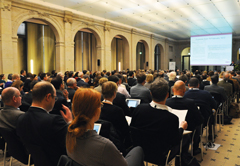Share and share alike?
At the 11th International APE Conference, a prestigious industry panel discussed whether the academic sharing economy adds value to the scholarly ecosystem. Tim Gillett reports

Sharing is the new buying, proclaimed Richard Padley in an early morning discussion at APE 2016 in Berlin.
The Semantico chairman, leading a panel talk on the rise of Scholarly Communication Networks (SCNs), suggested that many recent examples of successful business models were based on ‘disruptive innovation’ – citing Amazon, Uber and AirBnB as examples of enterprises that succeeded despite, or because of, the fact that they ignored traditional business wisdom.
SCNs such as ResearchGate, Academia.edu and Mendeley have formed part of the scholarly publishing scene for some time, based on the principles of sharing results, articles and data, encouraging discussion and information-exchange – and, some would say, fostering a ‘vanity factor’ for researchers keen for exposure.
Padley cited figures that suggested some 15 million articles have been uploaded to SCNs, with around 40 million members registered – and, though admitted that the figures needed to be ‘taken with a pinch of salt’, said that the importance of such networks was certainly growing fast.
Padley asked the assembled panel – comprising Fred Dylla, executive director emeritus of the American Institute of Physics, Charlie Rapple from Kudos, Grace Baynes from Springer Nature, Kent Anderson of Caldera Publishing Solutions, and Hannfried von Hindenburg of Elsevier – whether they thought SCNs added or removed value from the scholarly community, and whether the publishing industry as a whole has ‘missed a trick’ by underestimating the potential of SCNs.
Dylla outlined how he had been asked by STM to chair a working group to discuss the topic, pointing out that while SCNs’ rise to prominence has been relatively recent, that some of them have been in existence for a quarter of a century. Publishers are concerned that this new way of sharing subscription content is a threat to their business models – and, ultimately, their sustainability.
Following consultation, the group published a set of voluntary principles and asked organisations – including SCNs and publishers – to sign up to them. Members of the audience and the wider community were urged to read the principles – and comment – at www.stm-assoc.org/stm-consultations/scn-consultation-2015.
Baynes admitted that publishers had ‘missed a trick’, pointing out that SCNs were now meeting two ‘unmet needs’ – enabling the discovery of content in a way that publishers ‘have not nailed yet’, and allowing researchers to manage their reputation and to to gain more feedback from their peers.
Charlie Rapple from Kudos said she was not sure that individual publishers had necessarily missed a trick, given that they were constrained by the fact that they work as separate organisations – whereas SCNs are offering more of a ‘cross-community’ solution. However, she admitted that the publishing industry as a whole could have identified the need for such networks at an earlier stage.
It is not surprising that an ‘insurgent movement’ was required to ‘bend the rules and put all of our content into the same bin’, commented Anderson.
Elsevier’s von Hindenburg disagreed with Rapple, pointing out that publishers are all in the business of communication, and also in the business of reputation management – this explained the recent rise to importance of the ‘impact factor’. However, he acknowledged that publishers, while having managed the transition to the internet well, had perhaps missed out on the social angle of the internet somewhat, and the more fluid interpretation of reputations that it brings.
Dylla said he felt that a trick had been missed, given the rise of the three largest SCNs and the longevity of some of the smaller, more specialist networks. He said the community needs to learn from what SCNs have achieved, and to improve its own ability to deliver services to its customers. He added that publishers need to engage with the owners of SCNs more, to provide better services to a shared customer base. He said that while this was an optimistic ambition, his experience in the industry had led him to believe that the community as a whole was a very collaborative one.
Speaking from the audience, Digital Science’s Phill Jones pointed out that the specific community most difficult to engage with is researchers, and asked the panel how publishers could make sure they are better engaged in the future.
Dylla said that editors should be the ‘first point of outreach’ in such an initiative, as they represent the ‘front line’ in the connection between publishers and researchers. Rapple pointed out that only a small percentage of SCN members were active on an ongoing basis, and that publishers have a much more active relationship with the research community, through authors and editors:
She concluded: ‘We already have all the ingredients we need to make a success of this. We need to understand that publishing is only a small part of the process for researchers; whatever we do must not be too content-oriented, and we need to understand more fully how researchers are using these networks.’
The discussion was just one of many interesting presentations at the conference, chaired and organised superbly by Arnoud de Kemp and his team at the venue, the Berlin Brandenburg Academy of Sciences and Humanities. Other topics included: Science as Social Machines; New Ways of Building, Showcasing and Measuring Scholarly Reputation; Research Ethics and Publishing; Open Access Policies in Europe; and Wanted! An Infrastructure for Scholarly Communication! The entire conference was filmed by the River ValleyGroup, and can be viewed by readers at www.river-valley.zeeba.tv/conferences/ape-2016






